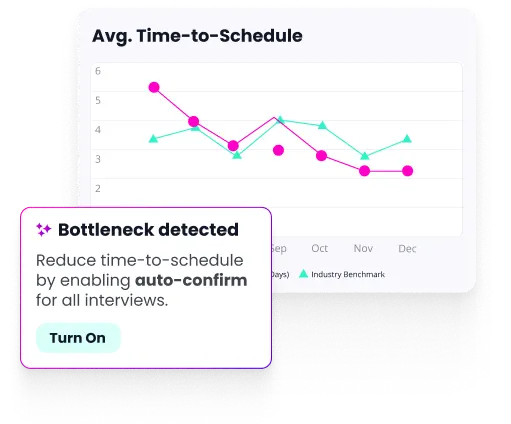2024’s hiring challenges and lessons learned

60%
of companies said their time-to-hire increased in 2024
60%
of companies said their time-to-hire increased in 2024
TA teams confront record-low hiring goal attainment in 2024
In 2024, TA teams achieved just 47.9% of their hiring goals—the lowest rate in the four years since we’ve been tracking them. Persistent challenges like scheduling delays, communication gaps, and rising time-to-hire, detailed in the section below, have made it harder to compete for top talent, and rewarding those who most enthusiastically embrace innovation.
Manufacturing’s struggles persist while healthcare rebounds
Healthcare, however, saw a notable rebound, climbing to 56%—its highest level since 2022.
The data portrays a challenging hiring environment across all sectors, with no industry surpassing 60% attainment for the third consecutive year. As talent acquisition leaders grapple with these hurdles, the need for innovative approaches, like automation and targeted workforce planning, has never been clearer.
What the healthcare sector got right
42%
more likely to have focused on decreasing time-to-schedule
44%
more likely to have focused on reducing cost-per-hire
21%
more likely to have increased personalization in the hiring process
Top overall hiring challenges
Other widespread challenges included unmanageable workloads for recruiting teams, adapting interviews for remote or hybrid work, and changes in company hiring policies — all of which further strained resources and slowed hiring progress.
"Recruiters have been maxed out at 120% for the last two years. What we've got to do is super difficult, but also super simple. We've got to draw a line and say, actually, I need to create bandwidth to redesign the recruiting process and workflows with AI first."

Hung Lee
Founder | Recruiting Brainfood
Rising time-to-hire: A growing concern
Compounding the challenges TA teams face—or perhaps as a result of them—is the persistent increase in time-to-hire. In 2024, 60% of companies reported that their time-to-hire had increased, up from 44% the previous year, while only 6% managed to reduce it. And this struggle was present across all sectors, with none managing to hire faster this year. This trend isn’t just delaying the hiring process—it’s increasing costs and causing companies to lose top candidates.
"Despite the 'Rise of the Machines' (AI tools), time to hire is also on the rise! AI tools can really impact and streamline processes, but ultimately when it comes to driving successful hiring outcomes and influencing hiring managers, a recruiter still needs to own this. The recruiter who is trying to finalize the hire is currently managing a far higher workload with less support."

Glenn Lindley
Director of Talent Acquisition | HighLevel
Scheduling issues and poor communication are lengthening time-to-hire
What’s behind the rise in time-to-hire? Persistent bottlenecks such as frequent interview cancellations, reschedules, and hiring manager delays continue to disrupt hiring timelines. However, a closer look reveals that many of these challenges stem from scheduling inefficiencies. When the pool of available interviewers is limited, even minor disruptions — like last-minute cancellations — can trigger rescheduling bottlenecks that slow hiring progress significantly. These delays risk losing top candidates to competitors and place additional strain on recruiting teams.
Poor communication with candidates — another top-cited issue — further compounds these inefficiencies, emphasizing the need for talent teams to adopt solutions that streamline workflows. As we’ll explore later, AI-driven scheduling and automation can help alleviate these pain points, ensuring faster coordination, better communication, and a smoother hiring experience for everyone involved.
Scheduling benchmarks
On average, customers who used GoodTime’s auto-scheduling feature confirmed interviews less than one day after requesting availability. And these interviews took place within five days of the original request— down one entire day from the previous year’s performance.
Time to Schedule
Time from when the scheduling process begins to when the interview takes place
144.9 hours
Manual confirm
120.1 hours
Auto confirm
Turnaround Time
The time between when an interview schedule is initiated and when the event is confirmed in a calendar
38.1 hours
Manual confirm
20.8 hours
Auto confirm
Lead Time
The time between when an interview is confirmed in a calendar and when the interview actually takes place
130.0 hours
Manual confirm
120.1 hours
Auto confirm
*GoodTime | 2024 Year in Review: https://goodtime.io/resources/2024-year-in-review/

GoodTime’s AI-driven scheduling helps TA teams reduce time-to-fill by as much as 50% — for both high-volume and corporate roles.
Learn more
Hiring teams still spend too much time on low-value work
27%
of TA leaders say their teams struggle with unmanageable workloads, up from 20% last year.
45%
report that more touchpoints are now needed in the hiring process compared to previous years.
51%
anticipate recruitment team turnover will present even greater challenges in 2025.
Remote and hybrid work arrangements still pose a challenge for TA leaders
27%
of TA leaders cited difficulty adapting interview processes to remote or hybrid environments.
26%
highlighted hybrid work challenges more broadly, such as managing distributed teams and balancing flexibility with productivity.
25%
pointed to candidates’ preference for fully remote roles as a critical hurdle in aligning expectations.
TA teams used AI and process improvement to level up
The transformative impact of AI
"AI is vividly loud right now, and thinking about how we can apply it to all the different work streams that we have in talent acquisition is probably at the forefront of anyone that is in a position like mine right now."

Rameen Fattahi
Director of Talent Acquisition | Rivian

Tools like GoodTime provide leaders with instant visibility into key hiring metrics, but also AI-powered recommendations to continuously improve their hiring processes.
Learn more
SMS and WhatsApp bridge candidate communication gaps
"We want to hire the best people in the world, and the technology that we choose to help us do that isn’t something that we take lightly. We're really focused on creating a seamless ecosystem that suits all of our end users' needs. That includes having information at their fingertips so they don’t have to jump from system to system to locate the information they need."

Carissa Spencer
Global TA Enablement & Operations Lead | Canva
Evolving talent teams: Growth, reorganization, and the role of AI
"We do need automation specialists on the team, whether that's recruiting operations or a role that is constantly looking at process design and enhancements. But we absolutely have to upskill our team, and we have to be creative when we think about what the roles are and how the work gets done."

Elaine Orler
Chief Strategy and Product Officer | Match2
More key trends at a glance
Layoffs rise again in 2024, but with
less severity
Employee performance and engagement hit a high note
DE&I continues to be deprioritized
To reverse this trend, TA leaders must move beyond intentions and take measurable action. This means investing in DE&I programs that align with business goals, leveraging technology to minimize bias, and ensuring that leadership accountability drives sustainable progress.
"The trick is to embed inclusion in the process so well, that it is scalable without many resources. AI can really help here—for example, using an augmented writing tool for job descriptions to ensure neutral language for attraction. Competency-based or skill-based interviewing further reduce bias, as do group decision making processes."

Manjuri Sinha
VP HR/Global Head of GTM Org Success & People Partners | Miro